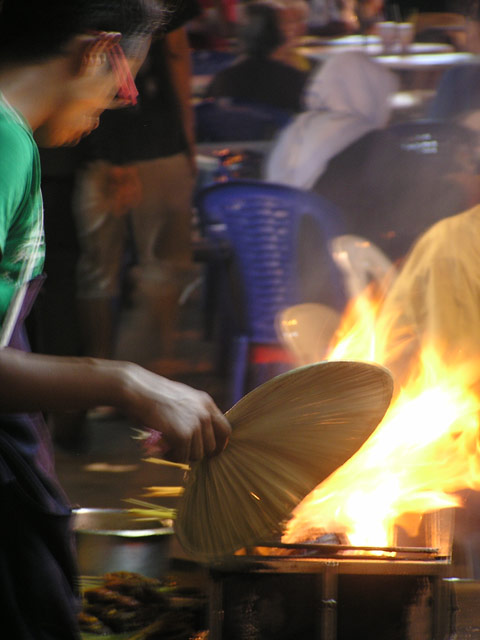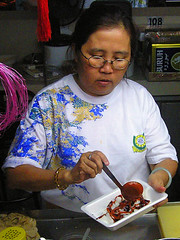Parking problems in downtown Kota Bharu, Malaysia. According to locals, this year the river was particularly high.
See also: I ♥ wet season, I ♥ hot season
Parking problems in downtown Kota Bharu, Malaysia. According to locals, this year the river was particularly high.
See also: I ♥ wet season, I ♥ hot season
As a casual photographer, there are not to be many moments when I rue the decision not to carry around a full-sized tripod, despite the highest ISO setting on my camera being 400. But this was one of those moments.
Kampung Baru’s (poorly lit) Sunday Market runs from around 6pm on Saturday night until the very early hours of Sunday morning, with street food in the foreground and those illuminated bamboo shoot-like Petronas Towers looming large behind. Kampung Baru itself is a fascinating slice of urban Kuala Lumpur at any time of day, as it is resolutely gripping onto the style of village life that tends to be erased in the mall-ification of Asian urban centers; which is why it was established in the first place. Listed in 1900 by the British as a Malay Agricultural Settlement, Kampung Baru was protected to attract rural Malays into Kuala Lumpur by mirroring the rural surrounds.
Location: Kampung Baru is behind the Kampung Baru LRT station.
See also: Masak Masak visits Kampung Baru’s Ramadan market; EatingAsia kicking it old school in Kampung Baru.
I know very little about tea, apart from what you learn by osmosis from your Anglo-Australian grandparents. I can make a decent cup of black tea but tend to regard it as a sort of beverage bycatch; something that fits well alongside pho or yum cha or fruitcake. I have no idea how it is grown, processed or traded in large quantities. I was in Tanah Rata in Malaysia’s Cameron Highlands and this emboldened me to find out.
The general image of smiling, passive locals hand-picking tea that is planted by unscrupulous tea advertisers the world over is as wrong as it is Orientalist. Most of the tea in the Cameron Highlands is semi-mechanically harvested. Two people standing each side of the row of tea drag the above device across the new shoots, which slices and blows the fresh tea into a bag. Less accessible bushes on the mountain peaks and the depths of the ravines are still harvested by hand, but this represents an absolute minority of the total tea produced. In lowland plantations, a modified combine harvester drives over the top of the rows. The tea is allowed to resprout fresh tips that are then reharvested about every three weeks.
Once picked, the leaves are withered, crushed, torn and curled by machine then set aside to oxidise. The oxidation process is called “fermentation” for purely historical reasons as nothing ferments. The tea, now turned from green to black from oxidation, is dried, sorted, tasted and packed.
Walking into the monsoonal wind on the waterfront, Kuala Terengganu, Malaysia
One of the great mysteries of eating in Penang is the economics of the hawker center. A group of vendors cluster around a kedai kopi, a cafe serving drinks and work almost independently of the cafe. Some pay rent, others are owned by the cafe, some seem to have agglomerated at a single point in an organic manner like a coral reef of wok burners accumulating on a restaurant atoll. The cafe often provides electricity and an awning to make monsoonal downpours tolerable for the vendors. Each cluster of vendors seems to be in competition, but there is value in assuring that the competing stalls all perform good business, thus attracting overflowing customers to your stall. The proper etiquette seems to be to order at the vendor at the front, then at least buy a single drink from the roaming waiter so that the kedai kopi owner gets their piece of the action.
Two hawker centres loom large. The Lorong Selamat center (above), with its reputation for serving the best char kway teow in Penang (and by inference, the world) and the ramshackle collection of hawkers on Swatow Lane (for ABC Special and Ice Kacang), just off Jalan Burma.
I’m apprehensive about the approach to anything as hyped and as personal as this char kway teow (above). I tend to place more value on the nubs of deep-fried pork fat, prawns and cockles that go into the dish (and the smoky wok hei flavour), than I value the core element: noodles. The noodles here are creamy and soak up charcoal smoke aplenty, a real lardy highlight. The only valid criticism is price. At RM7.50, the dish is roughly double the price of the average plate of char kway teow on Penang, a point that locals tend to debate and then eat on Lorong Selamat anyhow. It is too good not to eat there and the price serves as a talking point rather than deterrent.
We finished with a plate of lor bak, marinated lean pork wrapped in bean curd skin then deep-fried, served with a starchy bowl of broth thickened with egg and another bowl of chilli sauce. In this case, it was plated on top of an array of other deep fried delights and a local sausage.

Searing satay at Gurney Drive Hawker Center.
Gurney Drive’s Hawker Center is a roughly triangular lot encircled (entriangled?) by the most diverse set of street food vendors that you’ll find anywhere in Malaysia, alongside the mudflat-facing promenade. The road was named after Sir Henry Gurney, Malaya’s High Commissioner whose brief reign ended in 1951 when he was entriangled by Communist guerillas during the Malayan Emergency, and shot, allegedly sacrificing himself to draw fire away from his wife and driver. Unlike the sludgy foreshore, the hawker center does him no disrespect.
It smells of fried goods, dried squid, hae ko paste, laksa leftovers, and tourists. Despite being at the more commercial end of hawker spectrum, it is worth a visit just for the sheer variety available in a single, crowded venue. It is a place to begin trying to define what constitutes Malaysian street food in its infinite forms or just to establish a baseline, the culinary denominator for future Penang hawker meals.
At first, I started with a plan of moving from savory dishes to sweet-savory to sweets, with a palate-cleansing dried squid somewhere in between.
Within minutes this plan had fallen apart.
Popiah (above) has its origins in Fujian cuisine, with the Straits Chinese version made from a thin wheat flour pancake wrapping sliced jicama, bean curd, prawn and crab meat. This one was a little light on the crab…
…but the vendor had a perfect economy of movement in making them. There is value in eating food that is as entertaining to watch being constructed as it is to consume.
I passed on this dried squid, being too huge.
By all rights, muar chee (above) should not be as delicious as it looks. The vendor pulls a gelatinous blob of glutinous rice flour dough from a warmer, a blob which reminded me a little of the game pods from David Cronenberg’s eXistenZ.
She then proceeded to toss them into a perspex case filled with sugar, crushed peanuts and sesame seeds; dicing the blob whilst mixing and coating with the sweet/savory powder. The topping of dry-fried onions adds a crispy counterpoint to the chewiness of the rice flour.
This seafood curry mee has all the right elements: juicy prawns, a few blood cockles, opaque slices of pickled squid, congealed chunks of blood, and luscious chunks of fried tofu soaking up the curry broth. But it didn’t come together. The broth lacked the richness to carry the rest of the ingredients.


Chee cheong fun division of labor
I had a friend email me every few weeks to receive status updates on the amount and quality of chee cheong fun that I was consuming. Hello, Vin. The version of the dish that I’m more familiar with comes via Hong Kong with translucent sheets of noodle covering minced pork and prawns, topped with a light soy sauce.
The Penang chee cheong fun is even simpler. Sheets of noodle are rolled and sliced, then topped with local prawn paste hae ko, sesame seeds, and depending on your preference for heat, chili sauce.
No amount of eating can prepare you for the surprise of Penang rojak. What lies beneath the glossy, piquant and pungent shrimp sauce? Fruit? Seafood? In this case, both. The fruits of the sea came in the form of pickled squid; fruits from a tree in the form of green mango, papaya, starfruit and rose apple. The pineapple comes from a bromeliad which marks the outer edge of my botanical knowledge.
Rojak is a dish that shouldn’t fit together. There are too many elements, all of which vie for your attention: the diametrically opposed texture of squid and rose apple; sourness from green mango and lime juice (?); the trenchant odor of shrimp. But it works.
Location:Gurney Drive, Penang
A few years in Southeast Asia has me captivated by sour. I literally can’t get enough tamarind paste. In Cambodia, I’d buy it by the kilo block from the Russian Market and suck the piquant pulp straight from the seeds whenever I felt like an overwhelming sour kick. Lunch without a sour Khmer soup was not lunch.
Sour as a flavour profile on its own completes the full complement of a meal. It piques the tastebuds for food and always leaves you wanting more. It was also the prime attraction for me in Penang; the flavour around which I would centre eating the island. The one dish that I was after was assam laksa; Penang-style sour noodle soup. The broth is rich with mackerel, lemongrass, shallots and turmeric. Chilli, onion and chopped herbs (Vietnamese and common mint) are added to the bowl, raw; slippery white noodles and half a hard-boiled egg are mandatory. Thin slices of the bitter and peppery torchbud ginger flower top the dish along with an extra slug of hae ko, a local sweet shrimp paste. The souring comes courtesy of tamarind and semi-dried slices of the local fruit assam keping buah keping. Assam keping is dried slices of the fruit.
Laksa Air Itam, a roadside stall that sits alongside the Air Itam market has the reputation as the best laksa in Penang, something which I’m in no real position to assess because it was the first assam laksa stall that I hit. The stall has been in place for almost 50 years, passed patrilineally from father to son. A constant stream of laksa lovers laid a tactical assault on the stall. It was 3:00PM and streaming torrential rain (not a prime noodle soup hour) but buses disgorged a constant stream of patrons. Locals double-parked their BMWs to duck under the awning and pick up a clear plastic bag of the soup to take-away or hurriedly scarf down a bowl, rigidly huddled over the chromed tables on a flimsy metal stool.
The sour element is not as forward as I’d had before but the stock is complex and almost paste-like, thick with shreds of mackerel and the sticky hae ko paste. Despite the heartiness, a second bowl beckons: the true power of sour.
Location: Opposite the Air Itam market, near the junction of Jalan Air Itam and Jalan Pasar. Between Kek Lok Si temple and Bukit Bandara (Penang Hill) for anyone interested in tourism that doesn’t involve eating.
Price: RM2.50 (USD$0.75)
Also: I’m taking a break from writing for Christmas. See you in 2008 for more from Malaysia.